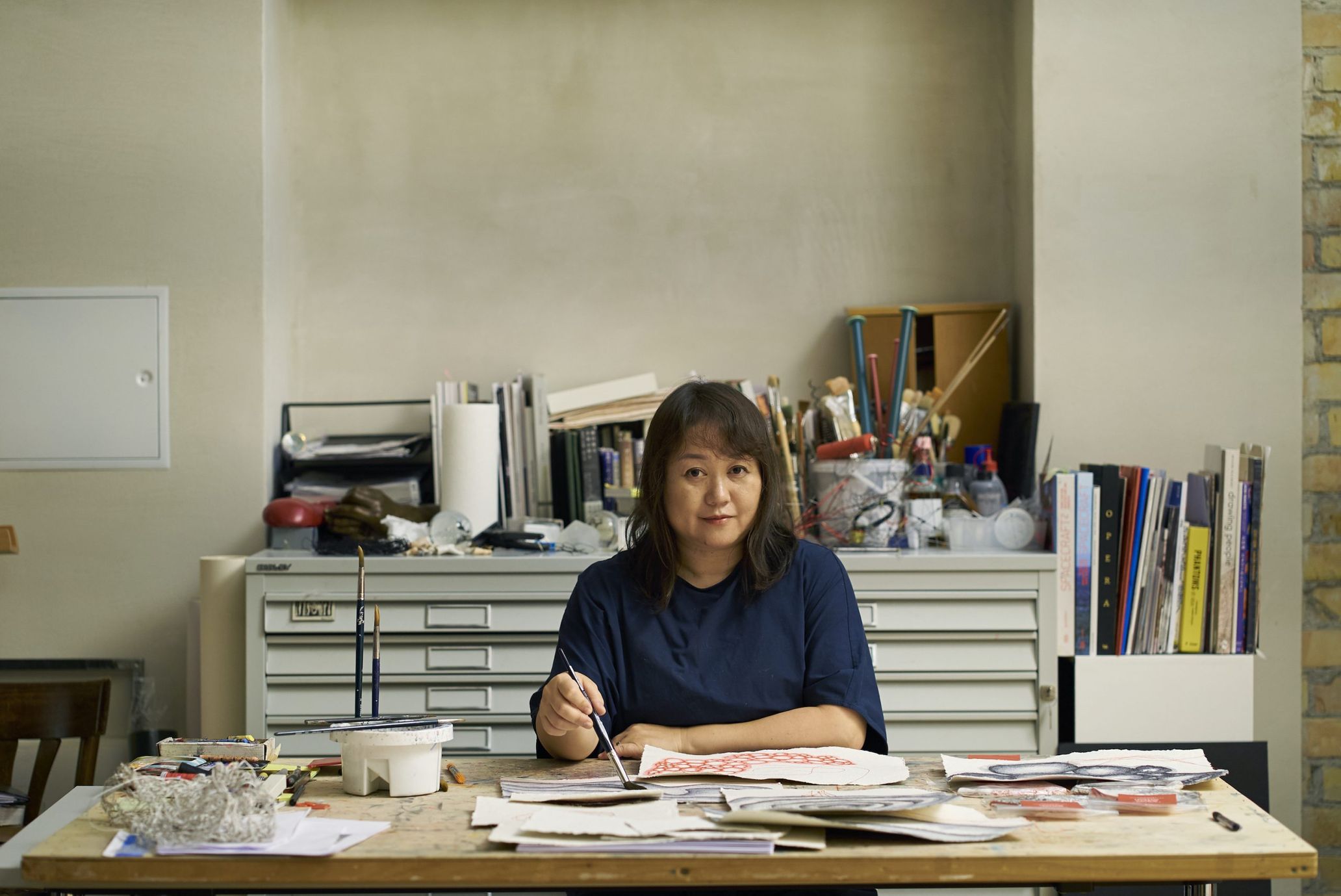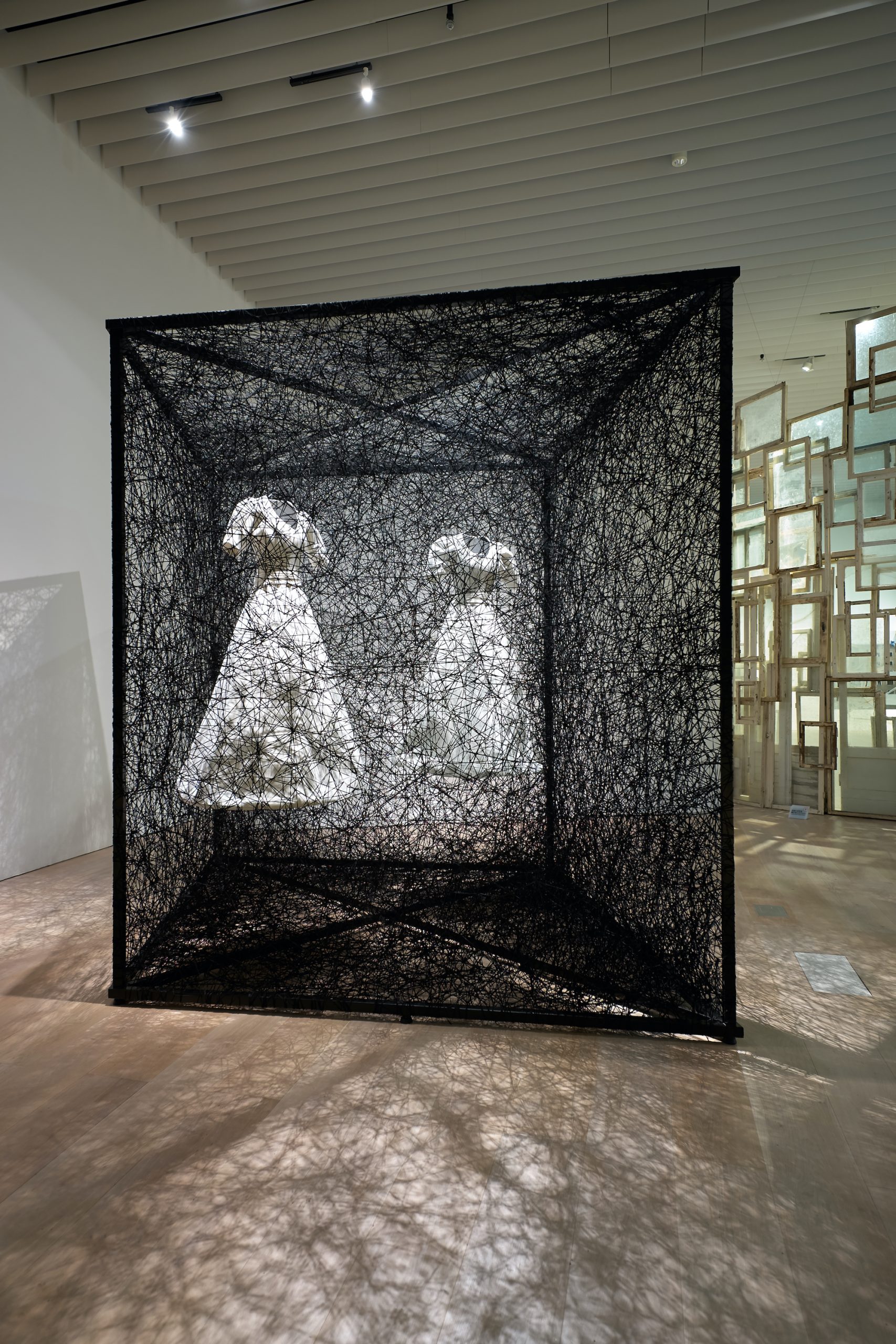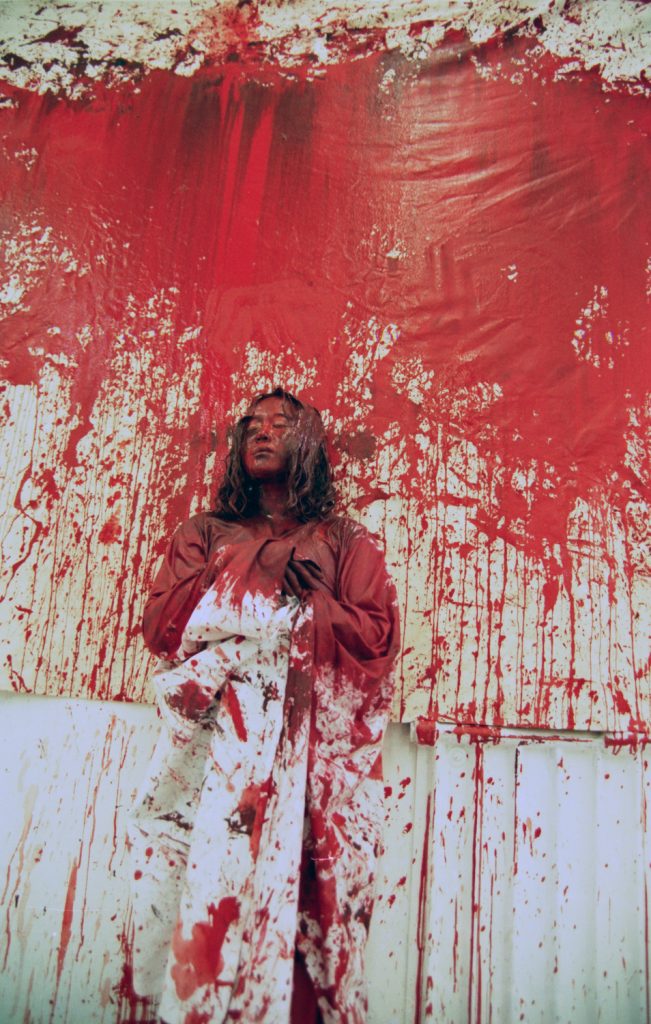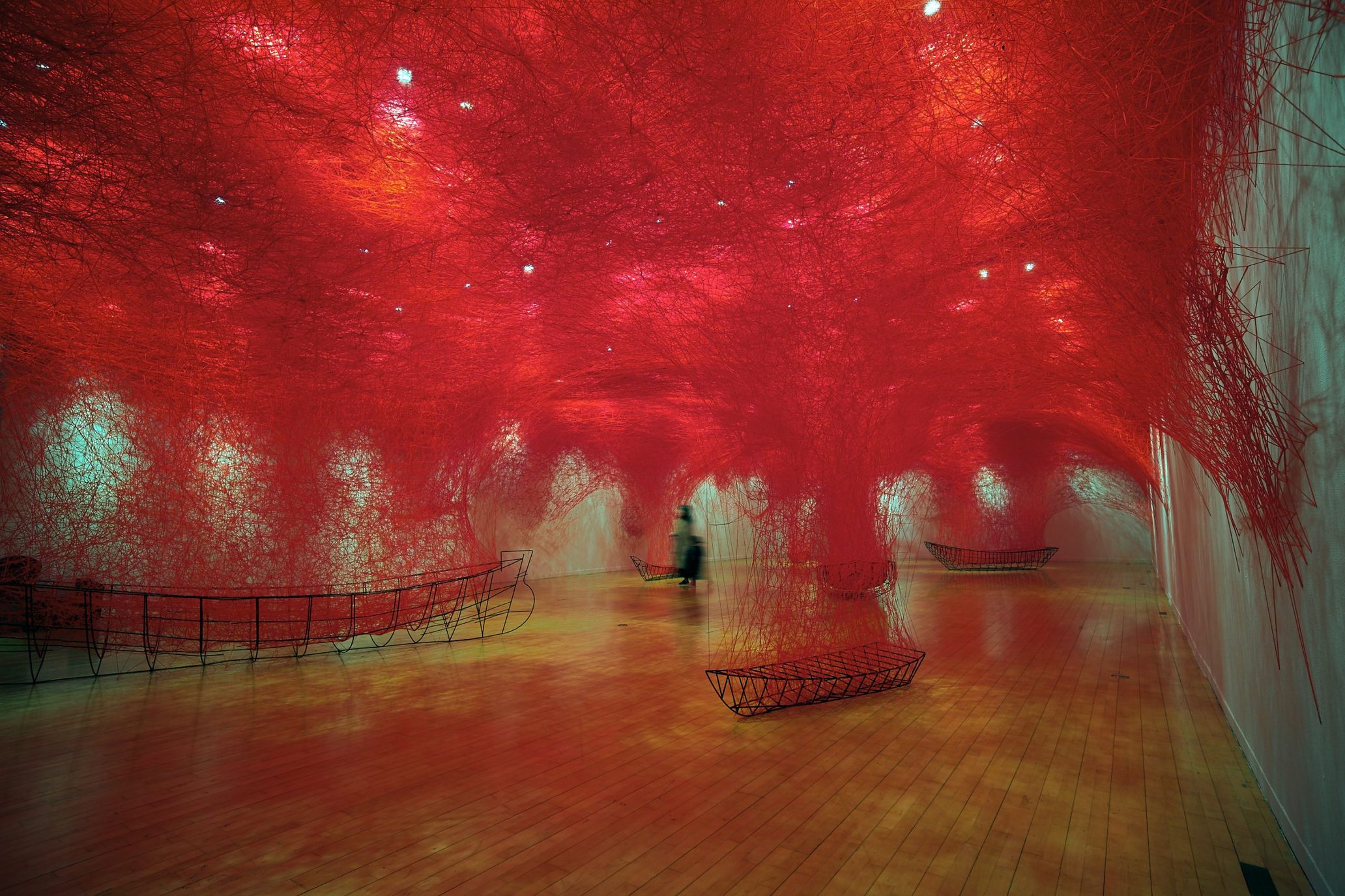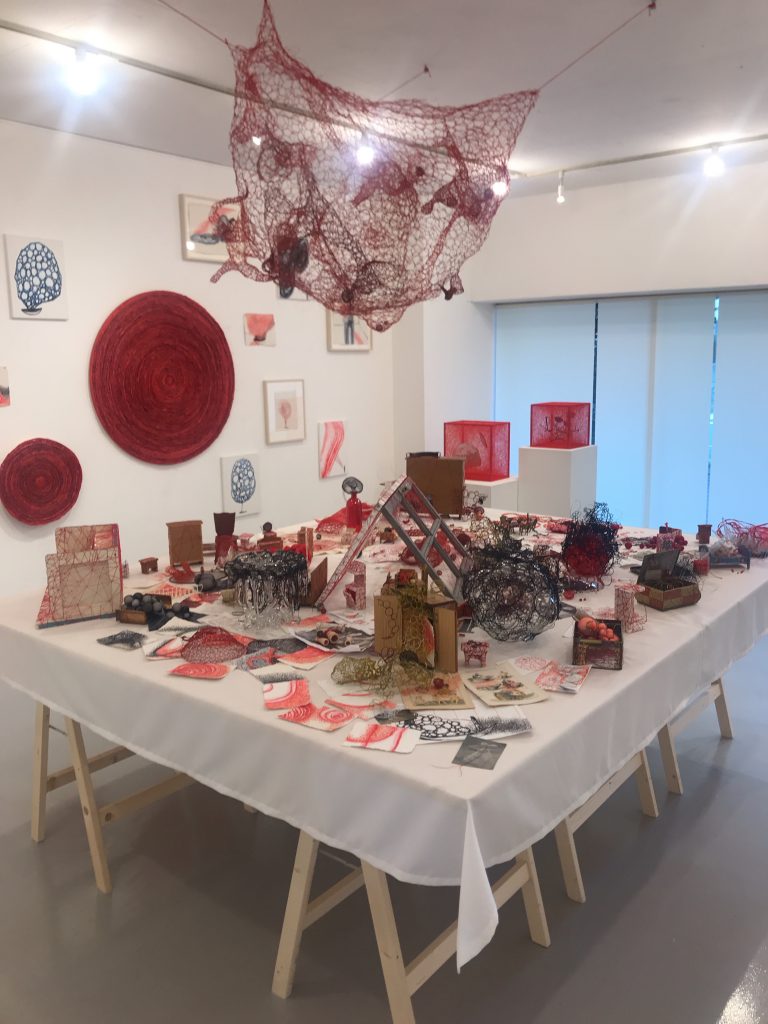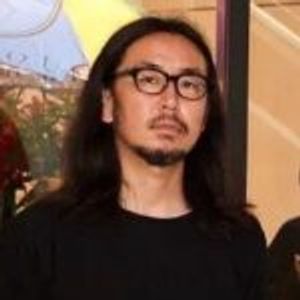Culture can be born out of a specific time and place, and yet, it possesses the ability to become timeless. In this series, “時音” TOKION invites people who are shaping culture today to talk about the past, present, and future.
This time, we talk to Berlin-based artist Chiharu Shiota. Shiota has had over 300 exhibitions in museums, galleries, and locations all over the world. She is known for her vivid performances and installations, which express the intangible: memories, anxiety, and dreams. Her works utilize threads strung across entire spaces, or materials with traces of people’s lives and memories such as dresses, shoes, and beds. They are simultaneously beautiful and powerful, with the ability to resonate with the viewer on a deeper level.
In 2019, she held her largest-ever solo exhibition at the Mori Art Museum. Titled “Chiharu Shiota: The Soul Trembles,” the exhibition looks back on 25 years of her career. After receiving a cancer diagnosis in 2017, she worked on this exhibition as she received treatment. And now, in 2020: With the coronavirus, the world has come face to face with an unprecedented danger, as we live in close proximity to the idea of life and death. In the context of today’s world, we ask Shiota about her artistic expression and thoughts on the body and soul.
――Your work is based on themes like life and death, or broad concepts like existence and connection, memory, and more. Could you talk about how you landed on these themes?
Chiharu Shiota: One thing that’s consistent in my work is presence within absence. Nobody is in the absence, but I still feel some sort of presence. For example, when a person passes away, looking at a spirit tablet brings back memories and makes us feel like that person is alive, which in turn makes us feel their presence on an even greater level. Memories aren’t something we can physically touch, but they have a greater influence on us than tangible things. I weave people’s memories into my work, expressing this connection through the act of weaving yarn.
――I get a feel of your reality in your art, like how you think of dresses as skin. Do you ever project yourself into your own work?
Shiota: I don’t project myself. Or someone’s existence. I look at my work from a detached perspective. Once I have a good enough idea of what I want to do, then I start thinking about the materials and the arrangement of the work. But at that point, I’m like an observer, or an artist appreciating the work.
white dress, mirror, metal frame, Alcantara black thread
Installation view: Shiota Chiharu: The Soul Trembles, Mori Art Museum, Tokyo, 2019
Photography Sunhi Mang, Photo Courtesy Mori Art Museum, Tokyo
© VG BILD-KUNST, Bonn & JASPAR, Tokyo, 2020 G2376
――Do you do that on purpose?
Shiota: If I get too close to the work, it becomes difficult for the viewer to immerse themselves in it. If you’re too moved by your own work, a lot of the time, it doesn’t become art.
――You started out with abstract paintings as a student, and then went on to work on stage design for operas and plays. What influence did your past experiences have on your three-dimensional expression?
Shiota: I always liked painting, but I started to feel like I was painting just to paint. The next thing I knew, I felt like I was no longer making my own work, but someone else’s work that I’d seen somewhere. I started to ask myself, “Who am I? What am I painting for?” And through that process, instead of painting on canvas, I began to express myself through installations.
――In the early days, you painted on yourself with red paint (“Becoming Painting”) and created installations with red thread. What does the color red mean to you?
Shiota: It’s the color of blood, so when I think about the connection between people, I use red thread. I think everything is contained in blood. Your family, country, or religion. The answer to your own identity or things that are hard to explain can be found in your blood. I feel that it all comes down to that.
Performance/Installation: red enamel paint
Australian National University School of Art, Canberra, Australia
Photography Ben Stone
© VG BILD-KUNST, Bonn & JASPAR, Tokyo, 2020 G2376
――Your exhibition “Shiota Chiharu: The Soul Trembles” was your largest-ever solo exhibition in your 25 years as an artist. Could you tell me about why you chose the theme of “The Soul Trembles” and what triggered you to create this exhibition?
Shiota: The day after I received an offer to do a solo exhibition from Kataoka (Mami) at Mori Art Museum, I was scheduled for a surgical exam. After the meeting, they found malignant cancer at the exam, and I was readmitted to the hospital. After that, they began to methodically remove my organs and proceed with cancer treatment.
What was bigger than the desire to make art was the fact that I was actually constantly confronting the reality of human mortality. Whether I was preparing for the exhibition, having a casual conversation, or eating with my family, I was constantly reminded that I was living close to death. I wondered what would happen to my 9-year-old (at the time) daughter if I died, what would happen to my thoughts and soul, and my connections.
――So it was your anxiety about surgery and treatment, as well as your desire to find grounding in art.
Shiota: Yes. Whether it’s cancer treatment or surgery to remove organs, everything is designed to be methodical. I wasn’t part of that process. My feelings were disregarded. Somewhere along the way, I felt like I was being treated like an object, or I suppose an indescribable feeling came over me, and I became unsure of what to do. When that happened, I would bring home the empty plastic bag used in my cancer treatment and stick tiny Christmas lights in it to create an illuminated piece of art. I’d put that on my bed, and that’s how I would confirm my existence. It was a process of finding myself. It was a difficult two years of struggling with hopelessness and conflict in my heart.
――So in that methodical process, it became difficult to strike a balance between body and soul.
Shiota: So, I tried asking my daughter and other kids her age, “What is a soul?” Until about eight to ten years old, kids have interesting replies. Like, “When my guinea pig died, I was really sad, and it was the first time I felt connected to my guinea pig’s soul.” Or, “I always fight with my little brother, but when he was hospitalized, I missed him from the bottom of my heart, and it was the first time I realized our souls were connected.” Their answers are definitely better than adults’. The connections between the soul or the mind has nothing to do with the color of your skin.
metal frame, red wool
Installation view: Shiota Chiharu: The Soul Trembles, Busan Museum of Art, 2019
Photography Sunhi Mang
© VG BILD-KUNST, Bonn & JASPAR, Tokyo, 2020 G2376
――At the time that you were holding the exhibition, what acted as an obstacle or a support?
Shiota: My only choice was to make art. When you make art, you feel like it fills a certain part of you that is missing, something you can’t communicate.
――On the other hand, what do you think about objectivity, or the position of the viewer that allows them to immerse themselves in the art?
Shiota: “The Soul Trembles” had many repeat visitors. Because it’s an installation, I thought that some people would be there just to take pictures on their smartphone, but it wasn’t only that. People were so into the work that they would visit again. There are times in my process where I feel the pain of entering the darkness, unable to move forward or backward, but the fact that so many people came to see my work has helped me a little bit, because it’s made me realize that this might be a common feeling for everyone.
――You said that this was your first exhibition where you were so close to death, and that this exhibition made you think about what it means to live or die. Now, in this year, with the looming threat of the coronavirus, have you been thinking about life and death again? Has it changed the way you think about creating or affected you in any way?
Shiota: Before, I used to have over twenty exhibitions a year, so I was barely in Berlin. But with the coronavirus, I’ve been able to spend time with my family for the first time in a long time, and it’s been amazing to be able to work on my art in my home studio. But there were times when I was painting and drew violent lines. The truth is that I was also subconsciously irritated. I feel like I struggled, or had some pent-up frustration.
――There have been changes in the way exhibitions are created or presented in our current situation, since international travel has become difficult.
Shiota: I’ve created work by directing remotely, but sometimes my exhibitions with existing works were actually successful, or my new work not as much…I suppose. During quarantine, when I was working in my home studio on pieces that just weren’t coming together, I would feel emotional about what might happen to my exhibitions that were postponed or cancelled. If exhibitions disappear, so do the concepts, and in turn, so does human thought. I didn’t know where to put those feelings, but some words came to me along with that feeling. Those words became the title for my exhibition, “Lost Exhibitions -Where should I put my feelings?” which is currently open in Tokyo’s Kenji Taki gallery.
But my words and the actual work I made in my studio didn’t match, which was difficult. With this current exhibition, I thought of my emotions, the process, and the exhibition as separate entities.
Photography TOKION
――Face-to-face conversations have become difficult as the digital world rapidly develops. What are your thoughts on the progression of the digital world?
Shiota: With more meetings and conversations taking place online, things have become more global and convenient. But it’s a strange feeling, because having conversations in your own living space exposes your personal life in a way. On the other hand, I think it’s positive that I can feel closer to people that I normally couldn’t see, being based in Berlin. But I do feel a trend towards localization.
――I heard that even at Berlin Art Week, there have been more opportunities to support artists from your own country.
Shiota: I’ve talked to other artists in my area, and the local flavor and vibe that Berlin used to have has been steadily fading. So it could be good to get that back. The connection between people should just be more local.
This has nothing to do with art, but since going through cancer treatments, I’ve started to like natto, which I couldn’t eat before. Now, I make it myself out of soybeans. I share my homemade natto with an editor friend and teach her how to make it. I was meeting with her almost weekly. Usually, I’d be the one learning from her since I’m younger, but I teach her how to make it, entirely online, because these are the times we’re living in. Maybe in the future, there’ll be a time where we’ll be able to easily consult artificial intelligence about our problems. Actually, that time has already come. I started thinking that because of natto and corona. A lot has changed with corona.
――Do you think there’s a possibility that your artistic expression will change after corona?
Shiota: With technology, it’s possible to paint well, play piano without any mistakes, or create a perfect electric circuit to perform an opera, but that’s not how people work. Messy lines and dissonance are things that are born out of the incompleteness that only us humans have. Maybe that’s the reason that only humans will remain in existence. And artists will keep making art in the gap between high-tech and low-tech. I’d like to continue to watch how people’s minds fill that gap.
Chiharu Shiota
Shiota was born in Osaka in 1972 and is currently based in Berlin. Confronting fundamental human concerns such as life, death and relationships, Shiota explores human existence throughout various dimensions by creating an existence in the absence either in her large-scale thread installations that include a variety of common objects and external memorabilia or through her drawings, sculptures, photography and videos.
In 2008, she received the Art Encouragement Prize from the Japanese Minister of Education, Culture, Sports, Science and Technology. In 2015, Shiota was selected to represent Japan at the 56th Venice Biennale. Her solo exhibitions across the world include Mori Art Museum, Tokyo (2019), Art Gallery of South Australia (2018), and the Yorkshire Sculpture Park, UK (2018), as well as numerous international exhibitions including the Sydney Biennale (2016) and the Kyiv Biennial of Contemporary Art (2018).
www.chiharu-shiota.com
Translation Aya Apton

